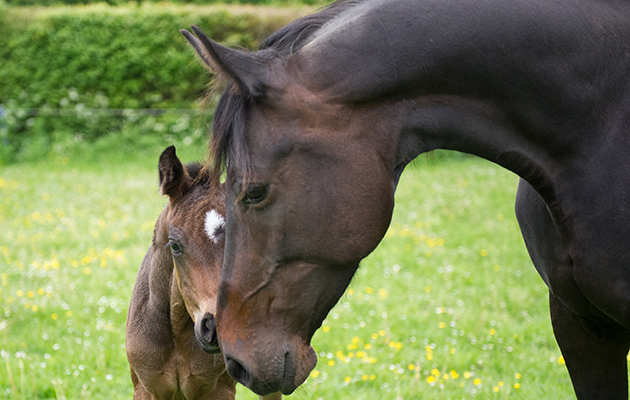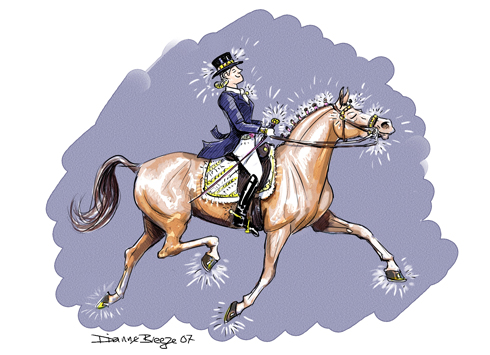Is your mare suffering from a hormone imbalance or is there something else causing that unwanted behaviour? Charlotte Thomas MRCVS investigates
Oestrus, or in-season behaviour, is easy to recognise in some mares. Signs can include frequent urination, squatting, everting the vulval lips to expose the clitoris (known as winking) and unpredictable behaviour that can be difficult to manage. Oestrus behaviour is a normal manifestation of the mare’s cycling breeding hormone levels throughout the year.
In non-domesticated herds, this behaviour is important to indicate to the stallion when the mare is receptive to covering and when she is at the point most likely to conceive within her cycle. Likewise, in a stud farm scenario, the mare’s responsiveness to a “teaser” (a stallion that is used to test if a mare is ready to be served) is used alongside ultrasound imaging to determine when is the best time to natural cover or artificially inseminate.
In equestrian situations not related to breeding, although this behaviour is not abnormal, it can be unwelcome. Problems can manifest in a subtle loss of performance to a mare that is unrideable when in season.
But are changes in behaviour related to a mare’s seasons? Before embarking on treatment to address unsavoury in-season behaviour, it must be ascertained if the mare’s reproductive system is actually the root of the problem. If the difficult attitude is shown all the way through the mare’s cycle during spring – as well as through the winter when most mares don’t cycle – it is unlikely that her reproductive hormones are the source of the problem. Lameness, back, teeth, gastric ulcers and training issues must be considered alongside hormonal causes.
A complex network of hormones
The signs of oestrus are caused by a complex network of hormones made in different organs of the mare’s body, including her ovaries. The main oestrus hormone is oestrogen and the main dioestrus (out of season) hormone is progesterone.
Most mares have a cycle of about 21 days. The mare will be in season for five or six of these days and then out of season for the remaining 15 or 16. At the end of the period of dioestrus, if a pregnancy has not been conceived, then hormone signals will be sent to expel the corpus luteum, which is the progesterone secreting structure in the ovary.
Oestrogen and progesterone are important in bringing about the physical changes in the body required for releasing an egg from the ovaries and supporting a pregnancy. They also promote or inhibit the action of different neurotransmitters in the brain, and therefore have a strong influence on behaviour.
Hormone changes
Some mares are more susceptible to hormone changes or show exaggerated signs of being in season. There can be an underlying cause, such as an ovarian tumour or urinary tract pain.
This means that a full veterinary examination, including an ultrasound and blood tests, is important. Once we have ruled out these problems we can look to diagnose a hormone imbalance.
Resting levels of the main oestrus hormones are likely to be the same in problem mares as they are in mares who do not show difficult oestrus behaviour. However, research has shown that when the adrenal glands are stimulated by a naturally occurring hormone called adrenocorticotropic hormone (ACTH), levels of progesterone, cortisol and testosterone are affected to a different degree in problem mares compared to normal mares. This suggests that it is not just the ovaries involved in the mare’s hormonal balance, and that the underlying physiology of difficult mares is different and therefore the problem is not all in the mind.
Undesirable behaviour
It would seem logical that, in the case of a mare exhibiting undesirable behaviour associated with being in season, removal of the ovaries (ovariectomy) would solve the problem. However, the manifestation of oestrus signs is due to low progesterone levels rather than high oestrogen levels. Therefore, removing the ovaries would remove the source of progesterone and may lead to more frequent and long-lasting oestrus signs.
Studies have shown that around 35% of mares continue to show signs of oestrus after surgical removal of both ovaries, making it a poor course of action for most mares. An exception to this would be when the ovaries were affected by a hormone secreting tumour known as a granulosa cell tumour (GCT).
These tumours account for 2.5% of all equine tumours and can cause three distinct behavioural patterns depending on the hormones they secrete. They can cause anoestrus (a lack of hormonal cycles), which often goes unnoticed by the owner unless they are actively trying to breed from the mare. They can also cause masculinisation if the main hormone involved is testosterone, leading the mare to show dominant behaviour and even try to cover the other mares in the field. Lastly, they can cause persistent in-season signs that can be a headache for the humans involved in their care. GCTs are diagnosed by ultrasound and the measurement of the blood hormone levels.
A frequent owner complaint is that their mare seems to undergo a “mega-season” in the spring when her regular cycles are replaced by a long period of oestrus of several weeks. This can often be explained by the mare going through the transitional period. Mares are seasonal breeders and therefore their ovaries and reproductive tracts are usually quiescent or in anoestrus over the winter period.
In the transition period between winter and the first cycle of the year, there may be several waves of the hormones involved in ovulation before the first egg is finally released from the ovary. This can keep the mare in season for a long period but will likely settle down as the hours of daylight increase as the year goes on. As the season goes on, some follicles become anovulatory or get stuck at the point of ovulation and instead of bursting to release an egg, continue to produce oestrogen, leading to a long period of being in season.
A softening follicle
It is known that some women get ovarian pain associated with ovulation and it may be the case that this is true for mares also. Any vet familiar with performing an ultrasound examination of the ovaries will have noticed that a softening follicle in the ovary will become more tender as the mare approaches ovulation.
Some mares have a persistent endometritis, which is an irritation of the uterus lining. This can be following a covering or spontaneous in older mares, often associated with poor vulval conformation, a tight cervix and decreased uterine defence mechanisms such as lymphatic drainage. This inflammation causes the release of prostaglandins from the uterus lining, leading to the mare coming back into season.
In conclusion, your mare’s vet can help investigate whether her difficult behaviour is linked to her seasons, and determine whether there are exaggerated oestrus signs or a physical problem such an ovarian tumour and therefore make a treatment plan.
The most common method
Treatment options include the removal of an ovary with a tumour, flushing the uterus if endometritis is present or the suppression of oestrus. The most common method to suppress oestrus is the use of synthetic oral progesterone, sold under the name of Regumate in the UK.
Another method gaining popularity is the use of a gonadotrophin-releasing hormone (GnRH) vaccine, which prevents the mare coming into season. However, the vaccine must be imported from Australia through a special licence.
There is an off-licence vaccine available in the UK, but the disadvantages can include muscle soreness at the injection site and potentially permanent infertility. It is cheaper and more convenient than daily progesterone.
Some vets have used plant oils infused into the uterus as a treatment option, as early research suggested this method could be effective. Later studies failed to show the effectiveness of this treatment and showed the method could result in uterine inflammation.
An older technique is the placement of a large glass marble inside the mare’s uterus to mimic a pregnancy and stop the mare coming into season. The results of this technique are variable and the marble can occasionally degrade, causing endometritis and threatening future fertility.
A new type of intrauterine device, called a Upod, is being developed. It is made of shatterproof magnetic beads that self-assemble into a ring in the uterus. It can be inserted at any time during the mare’s cycle and doesn’t cause endometritis. The owner can check the device is still present by using a metal detector.
There are various nutraceutical supplements for mares that have an anecdotal calming effect for the mare who seems to be at the mercy of her own hormones. Some of these may contain substances prohibited for competition horses, so it’s a good idea to check the ingredients with the help of your vet. In any case, thorough consultation with your vet to determine the best course of action is advisable.
Ref Horse & Hound; 16 April 2020
You may also be interested in…

11 supplements formulated to help hormonal mares

9 tips for getting the best out of your mare
Top riders share what they have learnt from experience about dealing with mares

Rebecca Penny: Mares can be extremely rewarding *H&H VIP*
Horse & Hound's showing columnist is encouraged to see more mares qualified for HOYS

Carl Hester: ‘I never wanted a chestnut mare, [but] I love this one’
Check out Carl Hester’s stunning prospect

Breeding from older mares: is it a good idea and what are the best methods?

15 reasons why mares are better than geldings
Gelding owners may beg to differ (many a mare owner might, too), but here's 15 reasons you could argue that

Subscribe to Horse & Hound magazine today – and enjoy unlimited website access all year round
